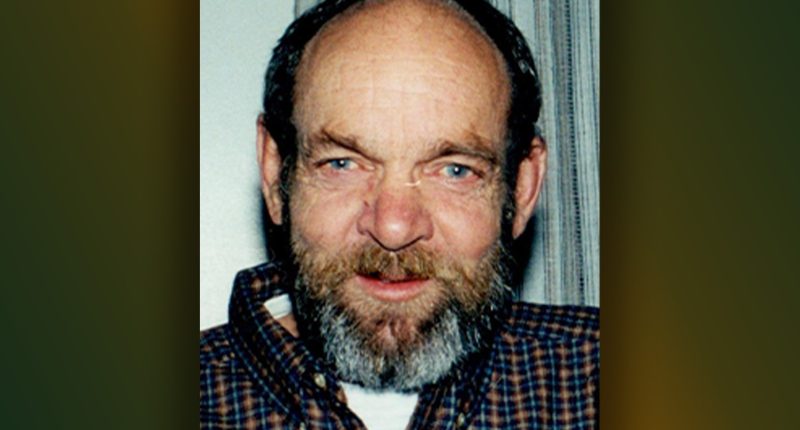Share this @internewscast.com
Two startling discoveries, made 15 years apart in the woods of New Hampshire, remained unresolved until a serial killer with multiple identities moved his deadly actions to the west.
Unknown Serial Killers of America, which airs Sundays at 7/6c on Oxygen, explored the case of Terry Rasmussen. This case still seeks the public’s assistance to identify a young Jane Doe and locate numerous others. Known as “The Chameleon Killer,” Rasmussen’s crimes created a complex and intricate web, which required early-stage genetic genealogy, eventually pointing to a dangerous man who had evaded law enforcement for years.
Bodies found in barrels at Bear Brook State Park
On November 10, 1985, police were summoned to Bear Brook State Park in Allenstown, New Hampshire — roughly 70 miles north of Boston — after a hunter found a 55-gallon barrel containing a suspected corpse in the thick woods. Retired Captain Ron Montplaisir of the Allenstown Police Department recalled that the hunter initially thought he had stumbled upon the decomposing remains of a female adult.
“The body was rolled up in plastic, and when the coroner later unwrapped the body, they discovered another body of a child,” he said. “Both bodies were decapitated.”
For years, authorities tried in vain to identify Jane Doe 1 and Jane Doe 2, but the cold case yielded few significant leads until 2000, 15 years later. Then, authorities found a second barrel in the vicinity, seemingly overlooked in the dense brush.
The drum contained the decapitated bodies of two female children, Jane Doe 3 and Jane Doe 4.
The adult female (between 25 and 30 years old) was confirmed as the mother of Jane Doe 2 (5 to 8 years old) and the infant-aged Jane Doe 4. Jane Doe 3, however, was biologically unrelated to the others and believed to be 2 to 4 years of age.
Despite painstaking efforts, all four victims would remain unidentified for years to come.
“The person who did this is a monster,” Montplaisir told Unknown Serial Killers of America.
A missing persons case in California
In September 2022, the Contra Costa County Sheriff’s Office in California received a report that 44-year-old Korean woman Eunsoon Jun had been missing for about four and a half months, according to now-retired Captain Roxane Gruenheid. At the time, loved ones were wary about her new husband, Larry Vanner, who’d seemingly isolated Jun from those closest to her.
“I would describe Eunsoon as a very loving, gentle soul,” said former roommate and long-term friend, Ying-Ling Wang. “Very intelligent.”
Jun moved to the United States as a teenager and earned her master’s degree in biochemistry. At the time of her disappearance, she worked at a pharmaceutical company and had been taken in by Vanner’s charm.
“We learned that Larry Vanner had been basically homeless, doing odd jobs that paid cash,” Gruenheid said.
Vanner provided changing stories about Jun’s whereabouts until settling on a scenario in which Jun had a nervous breakdown and sought psychiatric care in Oregon. Ultimately, the information didn’t pan out, and investigators grew more suspicious of Vanner after taking him in for questioning and finding nothing during a background check.
“Larry Vanner seemed articulate to me; he seemed intelligent to me, but I felt he was very, very calculating, and knew things, and was not telling us on purpose,” Gruenheid said. “I’d never come across someone who had no digital footprint.”
Vanner volunteered his fingerprints — presumably because he didn’t expect a fast return — and investigators found Larry Vanner was actually a parolee named Curtis Mayo Kimball, who once served two and a half years behind bars for child abandonment.
After sheriff’s officials arrested Vanner/Kimball on a parole violation, they went to his residence and found Eunsoon Jun’s mummified body in the garage. She had been dismembered and buried under hundreds of pounds of cat litter.
“The pathologist found a 3-inch cut to the vertebrae in the neck, and the cause of death was determined to be blunt force trauma to the forehead,” said Gruenheid.
Local pet store employees who sold 10 25-pound bags of cat litter identified Vanner/Kimball as the buyer, and the husband ultimately pleaded guilty to second-degree murder charges for Jun’s murder. He was sentenced to 15 years to life.
“But, if he believed I’d stop and go away, he didn’t know me,” said Gruenheid.
A look into Kimball’s past as Gordon Jensen
Authorities looked into the convicted killer’s background as Gordon Jensen, finding that in 1986, he lived at the Holiday Host R.V. park with his approximately 5-year-old daughter, Lisa, in Scotts Valley, California, about 30 miles south of San Jose. An older couple, the Deckers, believed Jensen was a struggling single father whose wife died of cancer, and the Deckers offered to adopt Lisa and take her to live in San Bernardino County.
“She didn’t have good clothes, unkempt, they heard her crying at night, and something was off,” said Det. Peter Headley of the San Bernardino County Sheriff’s Office. “Gordon Jensen wrote a letter to the Deckers, giving them permission to adopt her.”
Upon the relocation, Lisa began telling stories of how Jensen sexually assaulted her. But Jensen was soon in the wind, and San Bernardino County issued a warrant, charging him with child abandonment and molestation — charges that led to his 2002 arrest when first questioned about Eunsoon Jun’s whereabouts.
Following the killer’s 2003 conviction, Gruenheid, “on a hunch,” requested San Bernardino authorities send the DNA they took from 5-year-old Lisa back in 1986.
Lisa and Jensen were not related “in any way,” Gruenheid told Unknown Serial Killers of America.
“Where did she come from?” Gruenheid wondered. “And who is she?”
Detectives learn more about Lisa
Contra Costa and San Bernardino County officials tracked Lisa, then an adult, to learn more about the man she believed was her biological father. Little was gleaned, and in prison interviews between Gruenheid and Vanner/Kimball/Jensen, the man of many aliases was less than forthcoming about who Lisa was.
“He used terms like, ‘I remember having a girl, but I don’t know; I was drinking a lot back then,’” said Gruenheid. “And I knew he was just sitting there, lying through his teeth.”
A lack of databases in 2002 made it difficult for Headley and others to use Lisa’s DNA to find new information. In 2014, investigators employed the then-new method of genetic genealogy to try to locate any of Lisa’s relatives, and in March 2015, the genetic inquiry led to a man in New Hampshire.
The man said he had a cousin, Denise Beaudin, who moved away in 1981 with her six-month-old daughter, Dawn Beaudin, and was never seen again.
DNA testing proved that “Lisa” and Dawn Beaudin were the same person.
“The feeling is incredible, that finally, after all these years, we could finally tell Lisa who she is,” Headley said.
Relatives told New Hampshire police that in late 1981, Denise Beaudin and her daughter left to live with a man named Bob Evans. Denise’s father would pick the boyfriend’s photo from a lineup, and it was the same man sitting in a California prison for Eunsoon Jun’s murder.
Denise Beaudin has never been found.
ID the bodies in the barrels
By 2016, Headley had already established a rapport with NCMEC (the National Center for Missing & Exploited Children) to learn about “Lisa’s” true identity. It was thanks to the organization that Headley learned about the four unidentified bodies in barrels from New Hampshire’s Bear Brook State Park.
“That’s when everything really blew up,” Headley told Unknown Serial Killers of America.
A New Hampshire court ordered the four bodies found in 1985 and 2000 be exhumed from their graves. A DNA test proved the adult female was not Denise Beaudin, as some had suspected.
But what they did learn was that Jane Doe 3 — the 2- to 4-year-old child not biologically related to the others — was the biological daughter of Vanner/Kimball/Jensen/Evans. It directly tied him to the four murders.
“That’s when it’s like, ‘Holy smokes,’” Headley said. “This guy, who also killed Eunsoon Jun, was a serial killer. He’s been slaughtering people, literally leaving bodies from coast to coast.”
In 2017, researchers perusing Ancestry.com and other DNA-related websites contacted New Hampshire police with information from a 2007 post. In the post, siblings attempted to find their estranged father, Terry Rasmussen, and the information fit.
One of the siblings, Diane Kloepfer, told Unknown Serial Killers of America that she was only 6 when her mother took the kids and left Rasmussen.
“I have no memories of my father that are pleasant,” Kloepfer said. “My parents used to fight all the time, for hours and hours.”
Kloepfer described verbal and physical abuse at the hands of her father, including burning cigarettes on his children.
New Hampshire investigators visited Kloepfer and collected DNA, which proved she was the biological daughter of Terry Rasmussen and the half-sister to Jane Doe 3.
“I didn’t think I had a lot left to still break, but it broke me,” Kloepfer admitted.
About Terry Rasmussen
A birth certificate would later show Vanner/Kimball/Jensen/Evans was born Terry Rasmussen. He grew up in Colorado and left high school to join the U.S. Navy. He married his first wife and had four children, including Kloepfer, and spent part of the 1970s in the San Francisco Bay area.
As news of Rasmussen’s real identity reached the masses, Connecticut librarian and online sleuth Rebekah Heath perused internet message boards, stumbling upon a “young single mom” who’d disappeared with her two children in 1978, according to Headley.
The missing woman was Marlyse Honeychurch, and — like Denise Beaudin — moved with her children to live with her boyfriend. In Honeychurch’s case, the boyfriend went by his real name, Terry Rasmussen.
In 2019, DNA proved the unidentified mother found in Bear Brook was Honeychurch, and Jane Doe 2 and Jane Doe 4 were her missing children, finally putting an end to a decades-old mystery.
Forensic psychologist Dr. Rachel Toles said she believed Rasmussen managed to stay under the radar because “his prime motive wasn’t to kill, [it] was control and sexual abuse.”
“We know that he targeted single mothers who were vulnerable,” said Dr. Toles, adding that part of Rasmussen’s M.O. was to love-bomb his victims and isolate them. It was likely, Toles said, that Rasmussen became homicidal when the women in his life discovered or tried to end his abusive ways. He would then start again with a new name and new victims.
Terry Rasmussen died behind bars in 2010. Neither Denise Beaudin nor Jane Doe 3’s unidentified mother has ever been found.
“The frustration is you know there’s more victims,” Headley said. “While for years, Terry Rasmussen was an unknown serial killer, I’m just hoping that now somebody recognizes the M.O. and matches it up to someone they knew that moved away suddenly.”
Law enforcement believes Terry Rasmussen may have killed more than 20 women and children.
If you have information, contact investigators by emailing rasmussenvictimtips@gmail.com.
Don’t miss all-new episodes of Unknown Serial Killers of America, airing Sundays at 7/6c on Oxygen.









